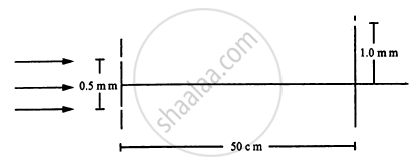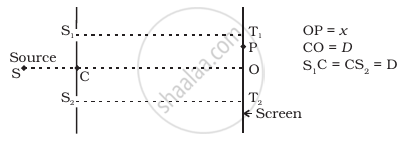Advertisements
Advertisements
प्रश्न
White coherent light (400 nm-700 nm) is sent through the slits of a Young's double slit experiment (see the following figure). The separation between the slits is 0⋅5 mm and the screen is 50 cm away from the slits. There is a hole in the screen at a point 1⋅0 mm away (along the width of the fringes) from the central line. (a) Which wavelength(s) will be absent in the light coming from the hole? (b) Which wavelength(s) will have a strong intensity?

उत्तर
Given:-
Separation between two slits,
\[d = 0 . 5 mm = 0 . 5 \times {10}^{- 3} m\]
Wavelength of the light,
\[\lambda = 400\text{ nm to 700 nm}\]
Distance of the screen from the slit,
\[D = 50 cm = 0 . 5 m\]
Position of hole on the screen,
\[y_n = 1 mm = 1 \times {10}^{- 3} m\]
(a) The wavelength(s) will be absent in the light coming from the hole, which will form a dark fringe at the position of hole.
\[y_n = \frac{\left( 2n + 1 \right) \lambda_n}{2}\frac{D}{d}\text{, where n = 0, 1, 2, ......}\]
\[\Rightarrow \lambda_n = \frac{2}{\left( 2n + 1 \right)} \frac{y_n d}{D}\]
\[= \frac{2}{\left( 2n + 1 \right)} \times \frac{{10}^{- 3} \times 0 . 05 \times {10}^{- 3}}{0 . 5}\]
\[= \frac{2}{\left( 2n + 1 \right)} \times {10}^{- 6} m\]
\[= \frac{2}{\left( 2n + 1 \right)} \times {10}^3 nm\]
For n = 1,
\[ \lambda_1 = \left( \frac{2}{3} \right) \times 1000 = 667 nm\]
For n = 2,
\[ \lambda_2 = \left( \frac{2}{5} \right) \times 1000 = 400 nm\]
Thus, the light waves of wavelength 400 nm and 667 nm will be absent from the light coming from the hole.
(b) The wavelength(s) will have a strong intensity, which will form a bright fringe at the position of the hole.
So, \[y_n = n \lambda_n \frac{D}{d}\]
\[ \Rightarrow \lambda_n = y_n \frac{d}{nD}\]
For n = 1,
\[ \lambda_1 = y_n \frac{d}{D}\]
\[ = {10}^{- 3} \times \left( 0 . 5 \right) \times \frac{{10}^{- 3}}{0 . 5}\]
\[ = {10}^{- 6} m = 1000 nm.\]
But 1000 nm does not fall in the range 400 nm to 700 nm.
Again, for n = 2,
\[ \lambda_2 = y_n \frac{d}{2D} = 500 nm\]
So, the light of wavelength 500 nm will have strong intensity.
APPEARS IN
संबंधित प्रश्न
The intensity at the central maxima in Young’s double slit experiment is I0. Find out the intensity at a point where the path difference is` lambda/6,lambda/4 and lambda/3.`
In Young's double slit experiment, describe briefly how bright and dark fringes are obtained on the screen kept in front of a double slit. Hence obtain the expression for the fringe width.
In a Young’s double-slit experiment, the slits are separated by 0.28 mm and the screen is placed 1.4 m away. The distance between the central bright fringe and the fourth bright fringe is measured to be 1.2 cm. Determine the wavelength of light used in the experiment.
Using analytical method for interference bands, obtain an expression for path difference between two light waves.
A monochromatic light of wavelength 500 nm is incident normally on a single slit of width 0.2 mm to produce a diffraction pattern. Find the angular width of the central maximum obtained on the screen.
Estimate the number of fringes obtained in Young's double slit experiment with fringe width 0.5 mm, which can be accommodated within the region of total angular spread of the central maximum due to single slit.
The intensity at the central maxima in Young’s double slit experimental set-up is I0. Show that the intensity at a point where the path difference is λ/3 is I0/4.
The separation between the consecutive dark fringes in a Young's double slit experiment is 1.0 mm. The screen is placed at a distance of 2.5m from the slits and the separation between the slits is 1.0 mm. Calculate the wavelength of light used for the experiment.
Find the angular separation between the consecutive bright fringes in a Young's double slit experiment with blue-green light of wavelength 500 nm. The separation between the slits is \[2 \cdot 0 \times {10}^{- 3}m.\]
A transparent paper (refractive index = 1.45) of thickness 0.02 mm is pasted on one of the slits of a Young's double slit experiment which uses monochromatic light of wavelength 620 nm. How many fringes will cross through the centre if the paper is removed?
How is the fringe width of an interference pattern in Young's double-slit experiment affected if the two slits are brought closer to each other?
In Young's double slit experiment using monochromatic light of wavelength 600 nm, 5th bright fringe is at a distance of 0·48 mm from the centre of the pattern. If the screen is at a distance of 80 cm from the plane of the two slits, calculate:
(i) Distance between the two slits.
(ii) Fringe width, i.e. fringe separation.
In Young's double-slit experiment, the two slits are separated by a distance of 1.5 mm, and the screen is placed 1 m away from the plane of the slits. A beam of light consisting of two wavelengths of 650 nm and 520 nm is used to obtain interference fringes.
Find the distance of the third bright fringe for λ = 520 nm on the screen from the central maximum.
In Young’s double slit experiment, what is the effect on fringe pattern if the slits are brought closer to each other?
In Young’s double slit experiment, what should be the phase difference between the two overlapping waves to obtain 5th dark band/fringe on the screen?
Young's double slit experiment is made in a liquid. The 10th bright fringe lies in liquid where 6th dark fringe lies in vacuum. The refractive index of the liquid is approximately
In Young's double slit experiment shown in figure S1 and S2 are coherent sources and S is the screen having a hole at a point 1.0 mm away from the central line. White light (400 to 700 nm) is sent through the slits. Which wavelength passing through the hole has strong intensity?

Consider a two-slit interference arrangement (Figure) such that the distance of the screen from the slits is half the distance between the slits. Obtain the value of D in terms of λ such that the first minima on the screen falls at a distance D from the centre O.

How will the interference pattern in Young's double-slit experiment be affected if the phase difference between the light waves emanating from the two slits S1 and S2 changes from 0 to π and remains constant?
Using Young’s double slit experiment, a monochromatic light of wavelength 5000Å produces fringes of fringe width 0.5 mm. If another monochromatic light of wavelength 6000Å is used and the separation between the slits is doubled, then the new fringe width will be ______.
In Young's double-slit experiment, the separation between the two slits is d and the distance of the screen from the slits is 1000 d. If the first minima fall at a distance d from the central maximum, obtain the relation between d and λ.
